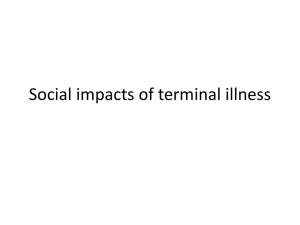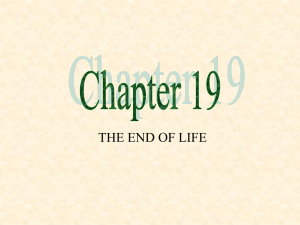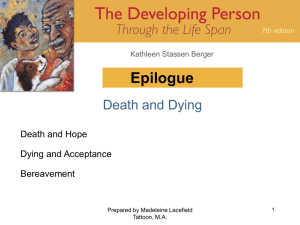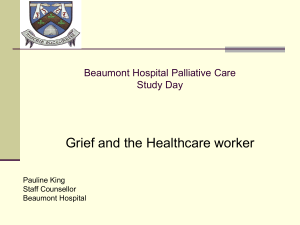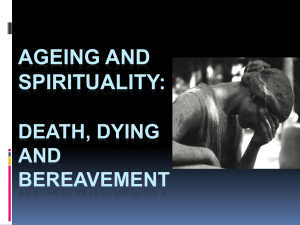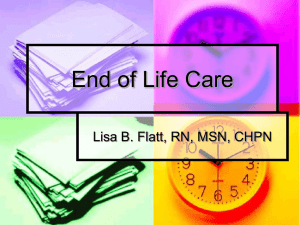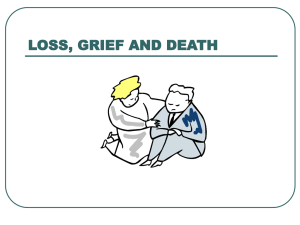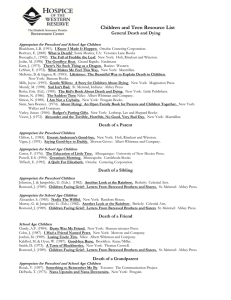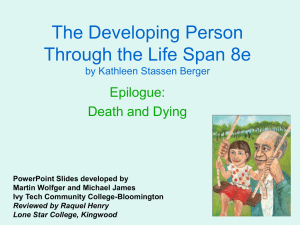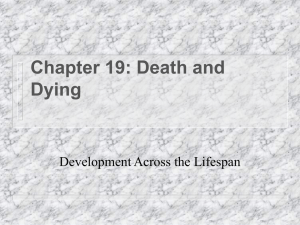Loss_and_Grief
advertisement
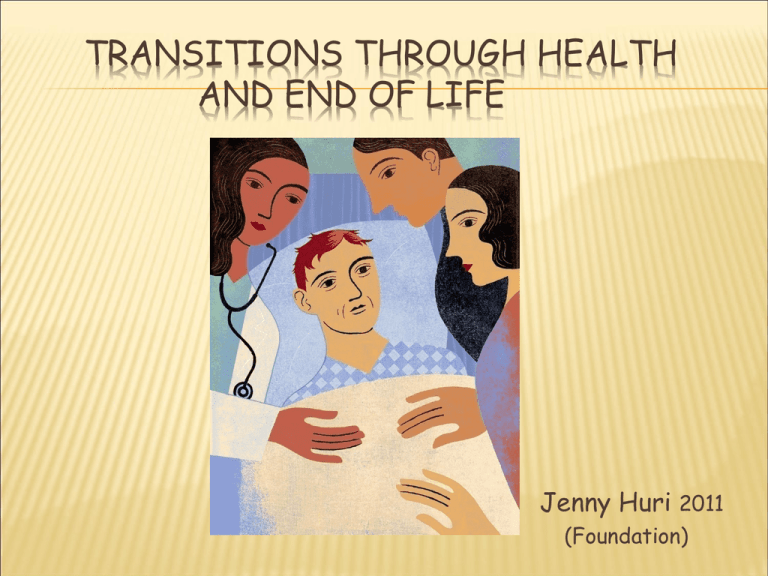
TRANSITIONS THROUGH HEALTH AND END OF LIFE Jenny Huri 2011 (Foundation) LEARNING OBJECTIVES Students will be able to Define and understand loss Define and understand grief Support the patient and family in grief Assess and support the dying patient and his family Identify actions that promote effective end of life care Learning outcomes 1 and 3 HEAL4002 One of the most difficult realities that nurses face is that, despite our very best efforts, some patients will die. Although we cannot change this fact, we can have a significant and lasting effect on the way in which patients live until they die, the manner in which death occurs and the enduring memories of the death for families (Smeltzer & Bare, 2005) NURSES …… are uniquely prepared to offer compassionate care for dying patients and their families. have a fundamental responsibility to alleviate pain and suffering. are educated in pain management, palliative care and in helping people cope with grief, death and dying. are key members of interdisciplinary teams caring for dying patients and their families PALLIATIVE CARE WHO – an approach that improves the quality of life of patients and their families facing the problems associated with life-threatening illness, through the relief of suffering by means of early identification and assessment and treatment of pain and other problems. WORLD CHAMPIONS!! LOSS LOSS is said to have occurred “when something or someone can no longer be seen, felt, heard, known or experienced. There is a sense of being deprived of something of value, of having something taken away against one’s will or of being robbed (Crisp and Taylor,2005) Understanding the meaning of loss is a vital aspect of caring for survivors and care givers LOSS Loss is a normal part of the life cycle People experience loss in the form of change, growth and transition The experience can be painful, frightening and lonely Triggers an array of emotional responses Can manifest itself in different ways. LOSS Age Gender Personality Cultural heritage Race religion LOSS CAN BE REFERRED TO AS………. Actual Perceived Maturational Situational ACTUAL LOSS Reduces the chance of attaining personal goals loss of sight Speech Mobility Limb Spinal injury PERCEIVED LOSS Dignity Confidence Self esteem Alteration of hope MATURATIONAL LOSS From being a baby Loss of childhood From teenager to adult From roaring 40’s to 50’s Life after 50 SITUATIONAL LOSS Sudden , unpredictable Physiological Social - Divorce Psychological Natural disaster Illness – life threatening or Chronic LOSS PRECIPITATES A PAINFULL HUMAN EMOTION ……… GRIEF !! CATEGORIES OF LOSS Loss is experienced in the form of : - Losing a loved one (person or pet) – life significant other - change (moving house, country, job) – known environment - health (illness or accident) aspect of self - losing things we own by accident or theft – external objects - our place in the world Precipitates a painful human emotion - Grief EMOTIONAL RESPONSES Denial Shock – “I feel numb” Disbelief – feeling of unreality Anger - hostility Unbearable loneliness Sadness Depression – hopelessness – worthless EMOTIONAL RESPONSES Social withdrawal – no one cares or really understands Apathy Longing for who or what was lost Blaming self or others – what you could have done, but didn't - guilt Questioning beliefs Feelings of panic - self destruction, desire to run away and “chuck it all in” PHYSIOLOGICAL RESPONSES Increase in heart rate Blood pressure changes Chest discomfort Shortness of breath – tightness in throat Appetite changes – digestive symptoms Sleep deprivation Abdominal upsets – hollow feeling in stomach Weight loss, hair loss, memory loss CHANGES IN BEHAVIOUR Purposeless activity Crying Lack of interest Easily distracted Forgetfulness Slow movements IT,S NOT SO SIMPLE …………. WHAT IS GRIEF ? The emotional suffering you feel when someone or something you love is taken away. A natural response to loss which we all experience at some time Usually associated with the death of a loved one – most intense The more significant the loss, the more intense the grief Very personal and highly individual experience – no right or wrong way to grieve STAGES OF GRIEF – ELIZABETH KUBLER- ROSS GRIEF IS A ROLLERCOASTER !!! Dr Patch Adams “the worst part for people who are considered to be dying is being treated as if they are already dead – people want visitors who are jolly fun and cheerful” “Dying is that process a few minutes before death, when the brain is deprived of oxygen, everything else is living” NON THERAPEUTIC COMMUNICATION False reassurance Sympathy Changing the subject Giving personal opinions Approval or disapproval Arguing BEREAVEMENT Bereavement is the actual process a person goes through following a significant loss It has been likened to thoughts and feelings following the experience of being robbed or deprived of something of value Something suddenly been yanked away (Crisp & Taylor, 2005) PROCESSES OF MOURNING T – to accept reality of loss E – experience the pain of loss A – Adjust to an environment that no longer includes the lost person , object or aspect of self R – reinvest emotional energy into new relationships Nurses and caregivers need to…….. accept diversity in the beliefs and responses of others. view each situation as unique. respond to situations in an honest, sensitive and caring manner. take time to intervene sensitively and appropriately when caring for those who have experienced a loss Nursing goals for dying patient Gaining and maintaining comfort Maintaining independence in ADL’s Reducing anxiety Ensuring feelings of security – do not leave alone Achieving spiritual comfort and forgiveness Gaining relief from loneliness and isolation Allow patient / family control & involvement Tailor to beliefs, customs and practices held by patients WHO GUIDELINES (2003) Provide relief from pain and other distressing symptoms Affirm life and regard dying as a normal process Neither hasten or postpone death Integrate the psycological and spiritual aspects of patient care Support patients to live as actively as possible until death Use a team approach to address the needs of patients and their families Enhance quality of life, and positively influence the course of illness CHRISSIE’S STORY http://www.youtube.com/watch?v=wVIVhYa2-ho&feature=related AN ANCHOR HAS BEEN LIFTED AND THE WAKA OF LIFE ROCKS. WE WHO ARE LEFT BEHIND WILL HOLD STEADILY TO THE COURSE YOU HAVE STEERED. HOEA CHRISSIE MO AKE TONU ATU
